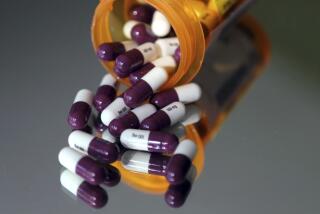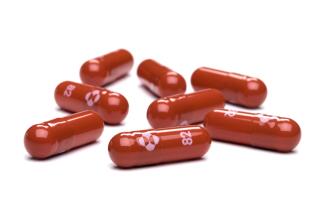Triple-Drug Treatment Shown to Inhibit HIV
WASHINGTON — In some of the strongest evidence thus far that a new generation of AIDS drugs can inhibit the human immunodeficiency virus, scientists reported Monday that HIV became virtually undetectable in most patients six months after starting treatment with one of the new drugs in combination with two standard ones.
“For the first time we may be close to achieving almost total suppression of the AIDS virus in most patients,” said Dr. Emilio Emini, executive director of the antiviral research division of Merck & Co., which makes indinavir, also known as Crixivan, a still-experimental drug in the new generation.
Addressing the Third Conference on Retroviruses and Opportunistic Infections, Emini said that the virus could not be found in the blood of 85% of the patients who took the triple combination, which also included the drugs AZT and 3TC.
Experts believe that AIDS cannot be cured, so the longtime approach has been to slow or eliminate disease progression through drug therapy, thus prolonging survival--ultimately, it is hoped, to a normal life span.
The new findings bolster those hopes that powerful drug combinations can delay the virus’ reproduction. As long as the virus has the ability to replicate, it can produce mutant strains, making drug resistance inevitable and rendering drug therapy ineffective. Researchers have been seeking ways to slow or stop replication to blunt the resistance phenomenon and better control the disease.
Thwarting the virus’ ability to reproduce also will help maintain the integrity of the immune system longer, so that the body will be less likely to become vulnerable to infections and other diseases, experts believe.
The research strengthens the view held by many researchers that the most effective way to combat AIDS is through combinations of potent drugs given as early after infection as possible.
Indinavir is a protease inhibitor, a powerful new family of antiviral AIDS drugs that scientists believe are many times more potent than the drugs that have been in widespread use for nearly a decade. They block production of protease, an enzyme crucial to the virus’ survival.
The first of this family, saquinavir, a Hoffman-LaRoche drug approved by the Food and Drug Administration in December, is regarded as the weakest of those in the pipeline. None of the other protease inhibitors has been licensed, although their approval is expected to be swift.
On Thursday, scientists studying another protease inhibitor, ritonavir, made by Abbott Laboratories, are expected to present equally compelling data, although of a different nature: They will report that treatment with ritonavir markedly slowed the progression of both disease and death in patients with seriously depleted immune systems.
This will be the first evidence that using this class of drugs can provide a clear benefit to patients.
“They work,” said Dr. Robert T. Schooley, chairman of the scientific program for the conference. “Acutely, they work very well. The strategy will be how to make them work over a long period of time. There is no question that this class of drugs is extremely important. They are more potent than any of the drugs we’ve been using for the last nine years.”
Protease inhibitors attack the virus at a late stage of replication, inhibiting the production of a key enzyme made by the virus, known as protease. Without it, the virus is unable to make new infectious copies of itself.
AZT and 3TC, and others from a group known as nucleoside analogs, hit the virus earlier at a different point in its reproductive cycle.
Dr. Roy Gulick and colleagues from New York University gave the three-drug combination--indinavir, AZT and 3TC--to 26 patients. After six months, they could not find any measurable levels of virus in the blood of 24 of them.
“This is the best response of any antiretroviral therapy that has been seen to date,” Gulick said.
The study compared a group of patients taking only indinavir to two other groups: one taking AZT and 3TC, and a third group that took all three drugs.
At the onset of the study, participants had a median level of virus in their blood of about 40,000 copies of viral RNA (ribonucleic acid, the genetic material of HIV) per cubic milliliter of blood.
In 24 of the 26 patients receiving the three-drug combination, HIV levels were reduced below detection (less than 500 copies) after six months. The result was the same for 13 of the 26 patients taking indinavir alone.
Although the group treated with AZT and 3TC alone showed lowered levels of the virus, it nevertheless remained detectable.
In a study that looked at indinavir in combination with AZT and DDI, another nucleoside analog, 59% of the patients (13 of 22) showed viral levels that dropped from 100,000 copies to less than 200 copies after five months.
Emini said that one of his earlier studies included a patient taking indinavir alone who has consistently shown undetectable HIV levels--and has remained healthy--for two years.
“The critical goal of therapy now should be to reduce viral levels and replication as much as possible, for as long as possible, in as many people as possible,” Emini said.






